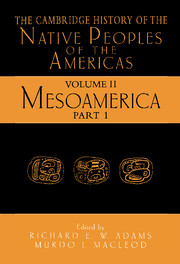Book contents
- Frontmatter
- Contents
- List of Illustrations
- Part I
- 1 Introduction to a Survey of the Native Prehistoric Cultures of Mesoamerica
- 2 The Paleoindian and Archaic Cultures of Mesoamerica
- 3 The Preclassic Societies of the Central Highlands of Mesoamerica
- 4 The Precolumbian Cultures of the Gulf Coast
- 5 The Maya Lowlands: Pioneer Farmers to Merchant Princes
- 6 The Central Mexican Highlands from the Rise of Teotihuacan to the Decline of Tula
- 7 Western and Northwestern Mexico
- 8 Cultural Evolution in Oaxaca: The Origins of the Zapotec and Mixtec Civilizations
- 9 The Southeast Frontiers of Mesoamerica
- 10 The Maya Highlands and the Adjacent Pacific Coast
- 11 The Aztecs and Their Contemporaries: The Central and Eastern Mexican Highlands
- Index
9 - The Southeast Frontiers of Mesoamerica
Published online by Cambridge University Press: 28 March 2008
- Frontmatter
- Contents
- List of Illustrations
- Part I
- 1 Introduction to a Survey of the Native Prehistoric Cultures of Mesoamerica
- 2 The Paleoindian and Archaic Cultures of Mesoamerica
- 3 The Preclassic Societies of the Central Highlands of Mesoamerica
- 4 The Precolumbian Cultures of the Gulf Coast
- 5 The Maya Lowlands: Pioneer Farmers to Merchant Princes
- 6 The Central Mexican Highlands from the Rise of Teotihuacan to the Decline of Tula
- 7 Western and Northwestern Mexico
- 8 Cultural Evolution in Oaxaca: The Origins of the Zapotec and Mixtec Civilizations
- 9 The Southeast Frontiers of Mesoamerica
- 10 The Maya Highlands and the Adjacent Pacific Coast
- 11 The Aztecs and Their Contemporaries: The Central and Eastern Mexican Highlands
- Index
Summary
INTRODUCTION
Although the scholarly investigations of Classic Maya civilization in the lowlands of Guatemala and Yucatan began more than a century ago, similar work in the southeastern Mesoamerican frontier of El Salvador and Honduras began only three or four decades ago. The serious investigation of the social dynamics of intersocietal contact in prehistory began in the past two decades. Although data are not ample for El Salvador and Honduras, they are sufficient to consider the countries as a frontier in prehistory, and explore how that frontier changed. Many theoretical models have been employed, including diffusion, acculturation, conquest, religion, trade, emulation, interaction spheres, frontiers and boundaries, dependency theory, and world system approaches among others.
The frontier model is emphasized in this chapter. Although it is in common usage, I try to avoid the term periphery because of its pejorative connotations. Viewing the area as peripheral to Mesoamerica or the Maya tends to discount autochthonous achievements. Scholars in southeastern Mesoamerica are beginning to separate indigenous traditions in architecture, artifacts, settlement patterns, and society from the effects of external groups. The use of the plural in the title is deliberate, as there are different kinds of frontiers (e.g., political, economic, ethnic, and religious), and frontiers change their location and nature through time.
A boundary or border is a line, while a frontier is a zone. A boundary such as the U.S.-Canadian boundary, may be static for long periods of time. A frontier usually is more dynamic, with internal ethnic or adaptive differentiation, and assumes contact of at least two different societies. That contact could occur when a more complex society expands into the territory of a less complex one, such as the western U.S. frontier in the nineteenth century, or it could be the contact between religious groups, as in the frontier between Christians and Moslems in the Near East. This frontier contrasts with the religious boundary that was the “Green Line” in Beirut. Likewise, it can be an economic frontier where a more centralized economy expands to exploit a resource in the territory of a decentralized economy, as illustrated by Brazilians exploiting Amazonian resources in the territories of native peoples. Occasionally, less complex societies expand into the territories of more complex societies, as with the Visigoths into Rome or the Mongols into China.
- Type
- Chapter
- Information
- The Cambridge History of the Native Peoples of the Americas , pp. 407 - 448Publisher: Cambridge University PressPrint publication year: 2000
- 3
- Cited by



